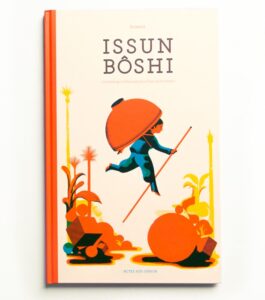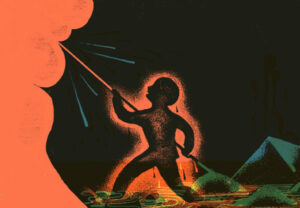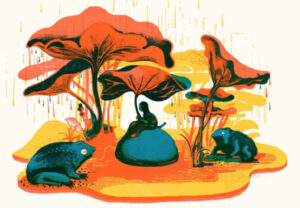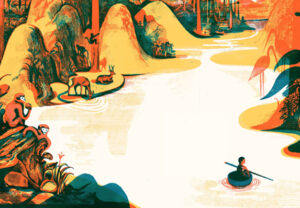 Issun Bôshi: The One-Inch Boy
Issun Bôshi: The One-Inch Boy
By Icinori
Little Gestalten
ISBN: 978-3-89955-718-3
$19.95
Ages 4-8
On shelves now
In the past, determining a bias in the publication of folk and fairytales was a fairly straightforward business. Too many European maids of hair as fair as the silk of corn on your shelves? Bias. But now we’re in the thick of a downturn in the publication of folk and fairytales. We not only need diverse fairy and folktales but we need more fairy and folktales at all! If you can find more than twenty published in a given year, that’s considered a good year. But desperation can lead to poor choices. A librarian might clutch at straws and snap up any such story, just so long as it fulfills a need. In the case of the latest adaptation of the story of Issun Bôshi to the picture book format, however, put your mind at rest. You rarely find such a meticulous combination of stunning art and melodic text as located here. Adapted from a Japanese folktale, Issun Bôshi by Icinori is a stunner. Regardless of whether or not you collect fairy and folktales, you need this on your shelf. Stat.
 “We’d like a little boy, any size at all. / We’d like him little, we’d like him small. / We’d love him tiniest of all.” Be careful what you wish for? Not really. When a childless peasant and his wife sing this song on their walk to and from the fields where they toil they are nothing but delighted when the wife gives birth to a kid that would give Stuart Little a run for his money. A clever fellow, Issun Bôshi (for so he is named) grows up and when the time comes he sets off to seek his fortune with just a needle and a rice bowl to his name. Along his travels he is waylaid by a fowl and tricky ogre. Issun Bôshi leaves him and continues further, but when a nobleman’s daughter is taken by that same sneaky demon, it is Issun Bôshi and his incredible size that saves the day once and for all.
“We’d like a little boy, any size at all. / We’d like him little, we’d like him small. / We’d love him tiniest of all.” Be careful what you wish for? Not really. When a childless peasant and his wife sing this song on their walk to and from the fields where they toil they are nothing but delighted when the wife gives birth to a kid that would give Stuart Little a run for his money. A clever fellow, Issun Bôshi (for so he is named) grows up and when the time comes he sets off to seek his fortune with just a needle and a rice bowl to his name. Along his travels he is waylaid by a fowl and tricky ogre. Issun Bôshi leaves him and continues further, but when a nobleman’s daughter is taken by that same sneaky demon, it is Issun Bôshi and his incredible size that saves the day once and for all.
Think of all the great fairytales and folktales that involve little people. You’ve your straight fairytales like Thumbelina and Tom Thumb. Your tall tales like Hewitt Anderson s Great Big Life and folktales like Pea Boy. That’s not even mentioning all the tales of elves and dwarfs and what have you. It hardly matters what culture you’re in. Little people, ridiculously little people, are a storytelling staple. I suppose tiny people make for instantaneous identification. Haven’t we all felt insignificant in the face of our great big world at some point in our lives? Wouldn’t we love it if we could overcome our shortcomings (ha ha) and triumph in the end? One of the interesting things about Issun Bôshi is that by the end of the tale he does attain tall status but only as a last resort. When offered height earlier in the tale he shows no interest whatsoever. Sure, he’d like to prove to the nobleman’s daughter that he’s more than a living doll, but as the ending of the book notes, “People say that Issun Bôshi sometimes misses being small.” Read into it whatever you want (missing childhood, missing the simple life when you’ve become “big” in the world, etc.).
 The art of the picture book translation is such that as an American who essentially speaks just one language, I am in awe. I’ve also read enough stilted, awkwardly translated books for kids to know when a book is particularly well done. All we know about the translation of Issun Bôshi is that the publication page says “Translation of French by Nicholas Grindell & Co. (Berlin & Ryde)”. So who knows whom the genius was who worked on this book! Whoever it was, it was someone who knew that this folktale would have to be read aloud many times, often to large groups. Heck, the very last line of the book is so beautiful and subtle that I’ve gone back to it several times. It reads, “People say that the nobleman’s daughter has taken a different view of Issun Bôshi and that their story is not yet over.” I vastly prefer that to a romantic ending or even the old standard “and they lived happily ever after.” This ending suggests that there could be more adventures to come and that their fate is not as fixed as your standard folktale would assign. Heck, we don’t even know for certain that they become romantically involved.
The art of the picture book translation is such that as an American who essentially speaks just one language, I am in awe. I’ve also read enough stilted, awkwardly translated books for kids to know when a book is particularly well done. All we know about the translation of Issun Bôshi is that the publication page says “Translation of French by Nicholas Grindell & Co. (Berlin & Ryde)”. So who knows whom the genius was who worked on this book! Whoever it was, it was someone who knew that this folktale would have to be read aloud many times, often to large groups. Heck, the very last line of the book is so beautiful and subtle that I’ve gone back to it several times. It reads, “People say that the nobleman’s daughter has taken a different view of Issun Bôshi and that their story is not yet over.” I vastly prefer that to a romantic ending or even the old standard “and they lived happily ever after.” This ending suggests that there could be more adventures to come and that their fate is not as fixed as your standard folktale would assign. Heck, we don’t even know for certain that they become romantically involved.
 Text text text. What about the art? Because it seems to me that in this world you’re often only as good as the pictures that accompany your tale. The author/illustrator of this book is listed only as the mysterious one-namer “Icinori”. Naturally I had to learn more and so in the course of my research (research = looking up information about the publisher) I discovered that Icinori actually two artists. On the one hand you have Mayumi Otero, a French illustrator. On the other you have Raphaël Urwiller, a graphic designer and illustrator. No word on who precisely was responsible for the wordplay here. All we really know is that for this book the art appears to consist of beautiful prints. The Japanese artistic influence is clear, though Icinori has come up with a very distinctive look of their own overall. The primary colors in the palette consist of blue, orange, and yellow. Best of all, there’s time for two-page silent spreads of pure unadulterated beauty. For example, once Issun Bôshi has set out to see the world the story slows down enough for you to witness a gorgeous river landscape, the water and sky a pure white while all around vegetation and animals vie for your eye. I love too how Icinori isn’t afraid to shift scenes between a busy city street scene and the tri-colored drama of Issun Bôshi being dropped down an ogre’s gullet.
Text text text. What about the art? Because it seems to me that in this world you’re often only as good as the pictures that accompany your tale. The author/illustrator of this book is listed only as the mysterious one-namer “Icinori”. Naturally I had to learn more and so in the course of my research (research = looking up information about the publisher) I discovered that Icinori actually two artists. On the one hand you have Mayumi Otero, a French illustrator. On the other you have Raphaël Urwiller, a graphic designer and illustrator. No word on who precisely was responsible for the wordplay here. All we really know is that for this book the art appears to consist of beautiful prints. The Japanese artistic influence is clear, though Icinori has come up with a very distinctive look of their own overall. The primary colors in the palette consist of blue, orange, and yellow. Best of all, there’s time for two-page silent spreads of pure unadulterated beauty. For example, once Issun Bôshi has set out to see the world the story slows down enough for you to witness a gorgeous river landscape, the water and sky a pure white while all around vegetation and animals vie for your eye. I love too how Icinori isn’t afraid to shift scenes between a busy city street scene and the tri-colored drama of Issun Bôshi being dropped down an ogre’s gullet.
There is a sense of relief that one feels when a book turns out to sound as good as it looks. Covers can be misleading. A title that looks like a gem on the outside can yield particularly dull or overdone results inside. Issun Bôshi, I am happy to say, never disappoints. It skips, it hops, it dives, it sings. It entertains fully and leaves the reader wanting more. It does not, therefore, ever come across as anything but one of the finest folktale adaptations you’ve ever seen. High praise. Great book. Must buy.
On shelves now.
Source: Sent to library for purchase.
Like This? Then Try:
- Pea Boy and Other Stories from Iran by Elizabeth Laird, ill. Shirin Adl
- Hewitt Anderson’s Great Big Life by Jerdine Nolen, ill. Kadir Nelson
- Tom Thumb by Richard Jesse Watson
Professional Reviews:



Will happily add this to my folk tale study!
Gonna get this one! Thanks.
I’ve loved this story for a long time, and have used other versions of it (of which there are few), paired with “Tom Thumb”, to get kids to write their own tiny-me stories. Always a hit! Look forward to seeing this one!